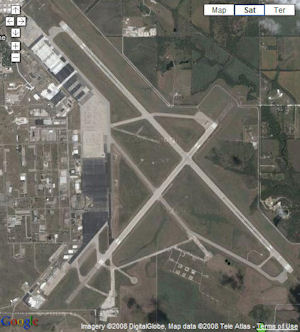Congress authorized the Topeka Army Air Field (TAAF) building project
within two weeks after the Dec. 7, 1941, attack on Pearl Harbor. Eight
months later, the completed air base -- essential buildings, hangars,
repair shops, steam heating plants, fuel storage and three 7,000 by 150-foot
paved runways -- was formally accepted by the Army Air Corps. In August
1942 the first troops arrived and had to be quartered in the agriculture
building on the Topeka Fair Grounds because their green wood two-story
barracks buildings weren't finished yet. By September 1942, the field
was the home of the 333rd Bombardment Group. By 1945 TAAF was one of
three B-29 centers where newly transitioned crews claimed new Superfortresses
and took off for the Pacific to aid in the  assault on the Japanese home
islands. On 31 October 1947 Topeka Army Air Field was inactivated.
assault on the Japanese home
islands. On 31 October 1947 Topeka Army Air Field was inactivated.
On 01 July 1948, Topeka Army
Air Field was reactivated as a Strategic Air Command base (SAC); home
to the 311th Air Division, Reconnaissance,
and to the 55th Strategic Reconnaissance Wing. That mission continued
until 14 October 1949, when the base was again inactivated. During that
activation, TAAF was renamed Forbes Air Force Base in memory of Maj.
Daniel H. Forbes, a Topeka pilot killed June 5, 1948, while testing the
Northrop XB-49 "Flying Wing" jet bomber near Muroc Dry Lake,
CA.
During the Korean War, Forbes AFB reopened and was again assigned to
SAC. on 16 February 1951 the 21st Air Division was activated at Forbes,
and thedivision's 90th Bombardment Wing moved to the base in February
and March. The wing trained SAC's newly activated 376th, 308th and 310th
Bomb Wings. From June 1951 to August 1953 it also trained B-29 replacement
crews for combat. About 10 a month were trained until August 1952 when
the bomb wing training program was concluded and the number of B-29 crews
produced was doubled.
On 16 June 1952, the 90th was redesignated the 90th Strategic Reconnaissance
Wing, Medium, and five months later started training recon crews as replacements
for Far East Air Forces. During October 1952, the 55th Strategic Reconnaissance
Wing moved to Forbes from Ramey AFB, Puerto Rico, continuing its program
of photography, photomapping and electronic reconnaissance. The 90th
and 55th Strategic Reconnaisance Wings flew Boeing RB-29 and RB-50 Superfortresses,
then the Boeing RB-47 Stratojets.
Satellite
image courtesy of Google.com
The planes were equipped with a bank of six cameras behind and below
the aft crew compartments. Aerial photo and electronic intelligence monitoring
became the primary mission of Forbes-based Wings during this period.
Such flights often put the planes and crews close to Korea and the USSR.
For the arrival of RB-47 jet aircraft in February 1954, a 12,000 foot
runway was constructed. Both the 90th and 55th Wings trained to combat
readiness and began overseas duty tours.


 assault on the Japanese home
islands. On 31 October 1947 Topeka Army Air Field was inactivated.
assault on the Japanese home
islands. On 31 October 1947 Topeka Army Air Field was inactivated.